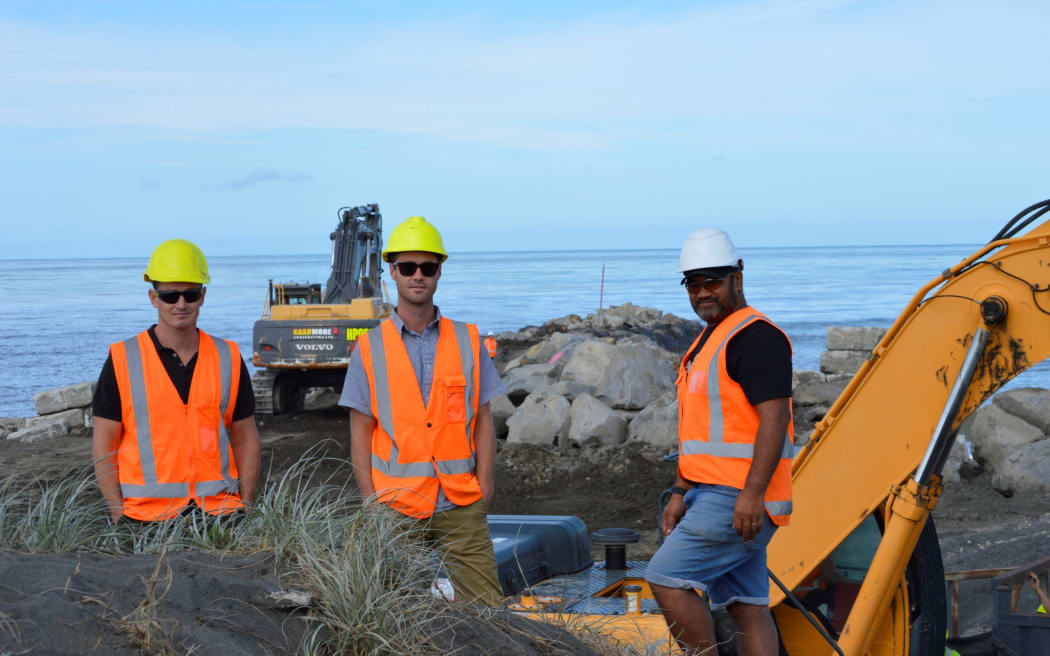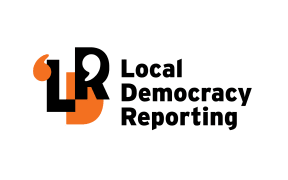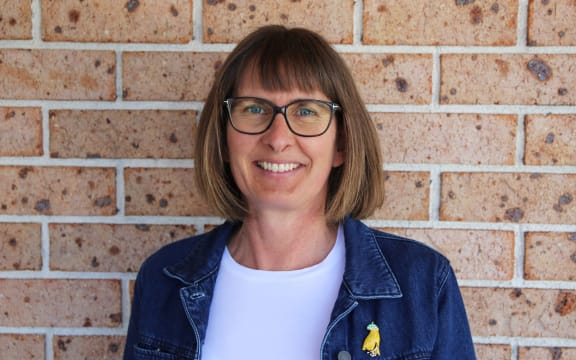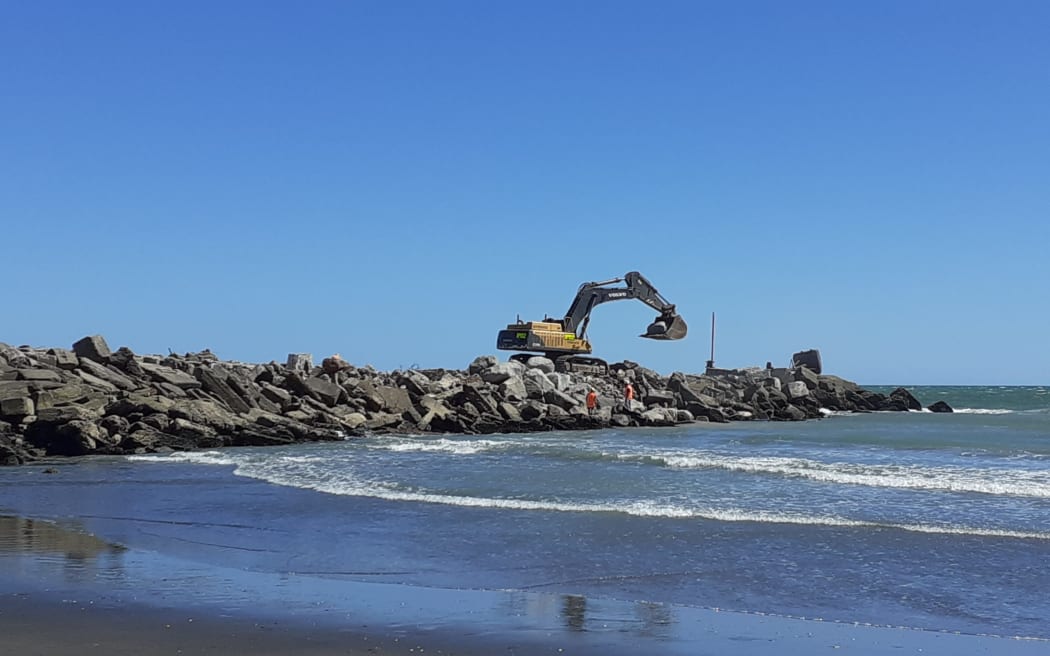Early stages of work on the Whanganui port upgrade are running over budget because of a new way of working under the legal status of the Whanganui River.

From left, Cashmore Contracting managing director Rob Cashmore, Horizons Regional Council project engineer Dougal Ross, and Kahurangi Simon, of Te Mata Pūau, at works to repair Whanganui’s North Mole. Photo: Supplied via LDR
The $50 million Te Pūwaha project has multiple partners and works programmes, and is the first major project giving effect to Te Awa Tupua legislation enacted in 2017, which grants the river system the legal rights of personhood.
Te Pūwaha aims to develop a modern marine precinct and secure the Whanganui port as a long-term economic and recreational asset.
Horizons Regional councillor David Cotton earlier this year described his council’s stage one and two overrun as a “$2 million-plus budget blowout” with consents costs over by 77 percent ($99,915), investigation and design by 96 percent ($153,995) and communications/project management by 156 percent ($1,297,636).

The Te Pūwaha partners are planning to publish a detailed update on their work programmes next week.
The infrastructure upgrade involves Whanganui iwi and four investment partners: Whanganui District and Horizons Regional councils, Q-West Boat Builders and Whanganui District Employment Training Trust, each responsible for specific parts of the upgrade. The government, through the Provincial Growth Fund, is contributing up to $26.75m of the current $50m budget.
Whanganui District councillor Rob Vinsen called on Tuesday for greater transparency and accountability around the district council’s works budget. He told the council Horizons had provided detailed reporting to its councillors, revealing that its project works were “considerably over budget”.
Vinsen said he was concerned Whanganui District Council could be in the same boat and asked why the same level of reporting was not being provided to Whanganui District councillors.

Horizons Regional Council chairwoman Rachel Keedwell. Photo: Supplied via LDR
Horizons Regional Council chairwoman Rachel Keedwell.
Horizons Regional Council chair Rachel Keedwell confirmed the Horizons’ works budget had over-run. That was because the original budget had not factored in the new way of working under Te Awa Tupua, she said.
“As our portion of the project has progressed, the consenting process has gone really well. This is because we have co-designed with iwi and consulted with the community prior to lodging,” Keedwell said.
“This front loading of work at the beginning of the consenting process in fact saves a lot of costs at the end.”
She told Local Democracy Reporting that increased construction costs nationwide had also had an impact.
“While we aren’t happy that costs have risen, the funding we received from central government has helped to accelerate the work and lessened the burden on ratepayers.”
The Horizons portion of the project focuses on maintaining river channel alignment to protect critical infrastructure (including the port, Three Waters and flood protection assets) from erosion and sea encroachment – a vital component of the wider Te Pūwaha project.
The work will protect and enable the Whanganui Port to develop and operate by defining the river mouth and ensuring a navigable depth is maintained for vessels.

Work on the North Mole as part of the Whanganui port upgrade. Photo: LDR / Moana Ellis
The work is being done in three stages:
Stage 1: The North Mole and revetment is about 55 percent complete with construction expected to finish in early 2023. The cost of the North Mole works is $8.6m including the construction, rock supply, consenting, design, communications and project management.
Included in this stage is the construction of two new fishing platforms. The 25-metre platforms, at a cost of $902,000, will be fit for purpose and provide greater access to the river. The cost is budgeted within the funded works for the North Mole.
Stage 2a: A consent application is being prepared for the reinstatement of the Tanae Groyne. Construction is expected to begin in 2023 at a projected cost of $1m (rock supply and placement).
Stage 2b: Design and consenting for the South Mole upgrade are under way. Community engagement has begun and construction is expected to start in late 2023. Initial investigations have indicated costs for this part of the project range from $3.6m to $27.75m, depending on levels of service – up to $22m over the original $5.2m budget.
Stage 3: The original Stage 3 works to upgrade the current erosion control structures along the South Spit and to replenish the South Spit embayment have been deferred due to cost increases.
It will be completed under a different funding stream in the future. Horizons said this work was important but less critical in maintaining river channel alignment, and upgrade measures would be developed under Te Pūwaha.
Keedwell said Te Pūwaha was an exciting and complex initiative.
“Upon its completion, Whanganui will have enhanced flood protection and a modern, purpose-built marine precinct. The work we are doing now will provide a community asset that will serve generations.”
The four projects under Te Pūwaha are:
- Whanganui District Council – upgrading wharves 2 and 3, developing marine infrastructure, providing a hardstand and runway suitable for a 300-tonne vessel hoist and dredging to assist the local boat building and marine industries.
- Horizons Regional Council – strengthening and repairing the North and South Moles, reinstating the Tanae Groyne and upgrading erosion control structures along the south spit.
- Q-West boat builders – establishing a purpose-built facility and 300-tonne vessel hoist for new builds, repairs, and maintenance services.
- Port Employment Precinct Whanganui – providing specialist training, retraining and upskilling for port activities and users.
Local Democracy Reporting is Public Interest Journalism funded through NZ On Air